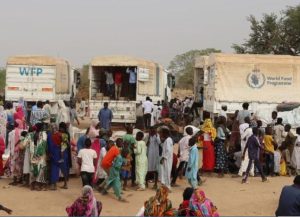Sudan refugee crisis deepens
A dire humanitarian crisis has emerged within the ongoing conflict in Sudan, with minority ethnic groups targeted by armed militia groups.
War erupted in Sudan in April between the country’s main military factions: the powerful Rapid Support Forces (RSF) paramilitary group – which has its roots in the Darfur region – and the regular army.
Reports say the RSF and allied militias, including the notorious Janjaweed, have wiped out at least 27 towns in Darfur.
Yale University’s Humanitarian Research Laboratory reports that their latest attack, on the town of Sirba, in West Darfur state, resulted in hundreds of civilians being killed.
West Darfur has been the epicentre of the recent violence, and has seen the RSF, which is led by Darfuri Arabs, target members of the non-Arab Masalit group.
Hundreds of thousands of Masalit civilians have fled across the border to eastern Chad and are living in difficult conditions.
Meanwhile, the World Health Organisation has reported the deaths of 65 malnourished children in border areas, and the recent onset of the rainy season has compounded the humanitarian misery.
Darfur saw experienced a major armed conflict that gained international attention in the early 2000s.
At the time, Sudan’s government and the Janjaweed were accused of widespread atrocities as they acted to crush an insurgency by rebels complaining of discrimination.
Violence flared again after feuding broke out between leaders of the army and the RSF.
Recently, the United Nations raised the alarm over ethnically motivated targeting and killings of Masalit, who comprise the largest single community in El Geneina, amid fears of a repeat of the atrocities.
Meanwhile, international relief efforts have ratcheted up as Sudan’s conflict enters a third month. But reports say the response is effectively being held back by funding and security constraints, and a long list of bureaucratic obstacles imposed by local authorities.
Relief workers are struggling to get visas, there are restrictions on importing supplies, and permits needed to move aid across the country are often being withheld, measures that suggest an attempt by authorities to tighten control over humanitarian efforts.
Some aid workers say the hurdles underscore the need for international donors to step up support for the local organisations better placed to operate in conflict hotspots.
Sudan has always been a tricky place for international aid agencies to work.
Humanitarian needs have been critical for decades and government institutions are known for closely monitoring foreign NGOs, some of which have been banned in past year.
Around 25 million people, or about half the population, are now in need of humanitarian assistance – and almost three million have been displaced by the fighting.
A large number of them are being supported by host families and communities.
The situation is particularly dire in Darfur – where RSF militias are accused of ethnically targeted violence – and in Khartoum where the army is bombing RSF ground forces with little regard to the millions of people still trapped in the city.
The UN says more than $3 billion is needed from international donors to fund the humanitarian response, both in Sudan and in the neighbouring countries that have received hundreds of thousands of refugees.
But aid groups are struggling to distribute what they do have. Although almost three million people have received aid since April, there are no safe humanitarian corridors to conflict-hit areas, leaving people reliant on neighbours and community aid networks.
Meanwhile, the army and government institutions have introduced a maze of administrative red tape holding up humanitarian aid.












